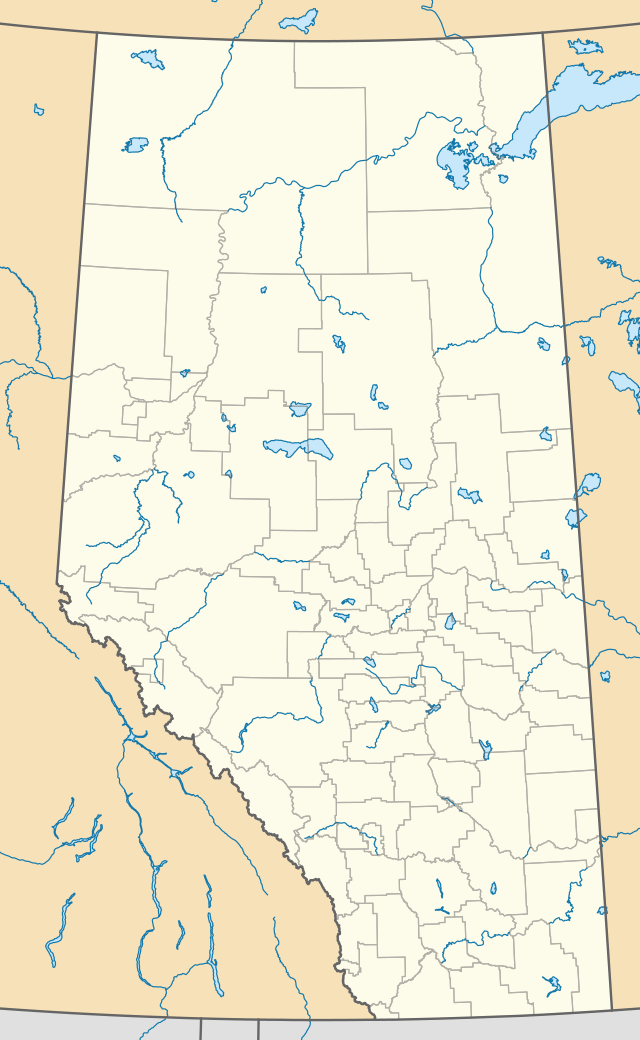Gleichen, Alberta
Gleichen /ˈɡliːʃən/ is a hamlet in southeast Alberta, Canada within Wheatland County.[1] It is located adjacent to the Siksika Nation at the intersection of Highway 1 and Highway 547, approximately 40 kilometres (25 mi) southeast of Strathmore. It has an elevation of 903 m (2,963 ft).[2]

History
It was named after Lord Edward Gleichen in 1884.[3] Gleichen was originally incorporated as a village on January 24, 1899 and then incorporated as a town on May 6, 1910. After nearly 100 years as a municipality however, Gleichen dissolved to hamlet status under the jurisdiction of Wheatland County on March 31, 1998.[4]
During the formation of the province, Gleichen was large enough to have its own seat in the Legislative Assembly of Alberta (see Gleichen provincial electoral district). Its population peaked at 668 according to the Canada 1921 Census.
Due to its proximity to the railroad, Gleichen was readily accessible to farmers and ranchers living in the area. Its mostly wooden structures however posed an increased risk of widespread fires. After the community burned a second time in 1912, many of its residents moved elsewhere, mostly to Calgary.
The Calgary Stampede originated in Gleichen as the Gleichen stampede. It then moved to Calgary in 1886.
Climate
Gleichen experiences a semi-arid climate (Köppen BSk).[5] Winters are long, dry and cold, while summers are short and warm. Precipitation is usually scant, with an annual mean of 336 millimetres (13.2 in).
| Climate data for Gleichen, Alberta | |||||||||||||
|---|---|---|---|---|---|---|---|---|---|---|---|---|---|
| Month | Jan | Feb | Mar | Apr | May | Jun | Jul | Aug | Sep | Oct | Nov | Dec | Year |
| Record high °C (°F) | 16.7 (62.1) |
22.0 (71.6) |
26.5 (79.7) |
31.1 (88.0) |
35.0 (95.0) |
37.2 (99.0) |
37.8 (100.0) |
37.8 (100.0) |
35.0 (95.0) |
31.0 (87.8) |
25.0 (77.0) |
21.7 (71.1) |
37.8 (100.0) |
| Average high °C (°F) | −3.4 (25.9) |
−0.1 (31.8) |
4.3 (39.7) |
12.5 (54.5) |
17.8 (64.0) |
21.6 (70.9) |
24.6 (76.3) |
24.7 (76.5) |
18.8 (65.8) |
12.6 (54.7) |
2.4 (36.3) |
−2.8 (27.0) |
11.1 (52.0) |
| Daily mean °C (°F) | −9.4 (15.1) |
−6.3 (20.7) |
−1.9 (28.6) |
5.2 (41.4) |
10.4 (50.7) |
14.5 (58.1) |
17.0 (62.6) |
16.6 (61.9) |
11.1 (52.0) |
5.2 (41.4) |
−3.3 (26.1) |
−8.6 (16.5) |
4.2 (39.6) |
| Average low °C (°F) | −15.4 (4.3) |
−12.5 (9.5) |
−8.1 (17.4) |
−2 (28) |
3.0 (37.4) |
7.3 (45.1) |
9.4 (48.9) |
8.5 (47.3) |
3.4 (38.1) |
−2.2 (28.0) |
−9.1 (15.6) |
−14.3 (6.3) |
−2.7 (27.1) |
| Record low °C (°F) | −46.7 (−52.1) |
−47.2 (−53.0) |
−38.9 (−38.0) |
−26.7 (−16.1) |
−11.1 (12.0) |
−2.8 (27.0) |
0.0 (32.0) |
−3.5 (25.7) |
−12.8 (9.0) |
−28 (−18) |
−36.5 (−33.7) |
−43.3 (−45.9) |
−47.2 (−53.0) |
| Average precipitation mm (inches) | 9.2 (0.36) |
7.8 (0.31) |
16.4 (0.65) |
20.0 (0.79) |
45.3 (1.78) |
64.1 (2.52) |
57.1 (2.25) |
44.5 (1.75) |
43.2 (1.70) |
11.2 (0.44) |
9.9 (0.39) |
8.8 (0.35) |
337.6 (13.29) |
| Average rainfall mm (inches) | 0.0 (0.0) |
0.0 (0.0) |
1.8 (0.07) |
13.5 (0.53) |
40.1 (1.58) |
64.1 (2.52) |
57.1 (2.25) |
44.5 (1.75) |
42.2 (1.66) |
6.8 (0.27) |
1.8 (0.07) |
0.3 (0.01) |
273.3 (10.76) |
| Average snowfall cm (inches) | 9.0 (3.5) |
8.0 (3.1) |
15.0 (5.9) |
7.0 (2.8) |
5.0 (2.0) |
0.0 (0.0) |
0.0 (0.0) |
0.0 (0.0) |
1.0 (0.4) |
4.0 (1.6) |
8.0 (3.1) |
9.0 (3.5) |
65.0 (25.6) |
| Source: Environment Canada[6] | |||||||||||||
Demographics
As a designated place in the 2016 Census of Population conducted by Statistics Canada, Gleichen recorded a population of 324 living in 137 of its 172 total private dwellings, a change of -3.6% from its 2011 population of 336. With a land area of 1.45 km2 (0.56 sq mi), it had a population density of 223.4/km2 (578.7/sq mi) in 2016.[7]
As a designated place in the 2011 Census, Gleichen had a population of 336 living in 150 of its 173 total dwellings, a -3.4% change from its 2006 population of 348. With a land area of 1.48 km2 (0.57 sq mi), it had a population density of 227.0/km2 (588.0/sq mi) in 2011.[8]
See also
References
- Alberta Municipal Affairs (2010-04-01). "Specialized and Rural Municipalities and Their Communities" (PDF). Archived from the original (PDF) on 2012-02-29. Retrieved 2010-07-08.
- "Alberta Private Sewage Systems 2009 Standard of Practice Handbook: Appendix A.3 Alberta Design Data (A.3.A. Alberta Climate Design Data by Town)" (PDF) (PDF). Safety Codes Council. January 2012. pp. 212–215 (PDF pages 226–229). Retrieved October 9, 2013.
- Lindman, Doris (3 February 2010). "Siding #12 brings settlers west". Strathmore Standard. Retrieved 1 August 2013.
- "Order in Council 61/98" (PDF). Province of Alberta. February 25, 1998. Retrieved October 10, 2015.
- http://upload.wikimedia.org/wikipedia/commons/b/ba/North-America_Koppen_Map.png Köppen climate classification map of North America (University of Melbourne)
- "Gleichen, Alberta". Canadian Climate Normals 1981–2010 (in English and French). Environment Canada. Retrieved August 8, 2014.
- "Population and dwelling counts, for Canada, provinces and territories, and designated places, 2016 and 2011 censuses – 100% data (Alberta)". Statistics Canada. February 8, 2017. Retrieved February 13, 2017.
- "Population and dwelling counts, for Canada, provinces and territories, and designated places, 2011 and 2006 censuses (Alberta)". Statistics Canada. 2012-02-08. Retrieved 2012-04-07.